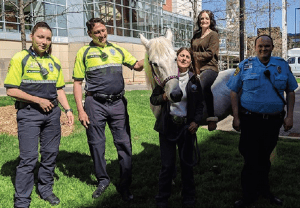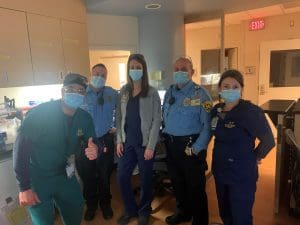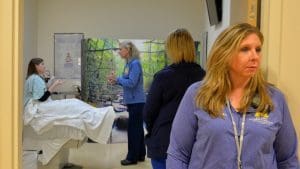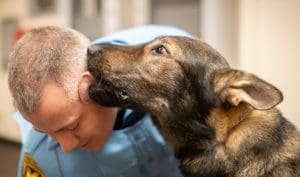A ‘safe neighborhood’ program protects staff.
Takeaways:
- Community policing-based security strategies in healthcare organizations focus on trust, training, and technology and treat each unit or floor as a unique neighborhood, where security engages with patients, staff, and visitors.
- Nurse educators, security, and law enforcement can work together to develop and deliver scenario-based training specifically designed for the healthcare environment.
- Trust is the first pillar of security, and is critical to effectively implement security technology strategies.
Editor’s note: This is a web exclusive article for the November 2021 issue of American Nurse Journal.
On November 6, 2014, two nurses were knocked to the hospital floor—one suffered a collapsed lung, the other a fractured wrist. The patient, a 68-year-old man experiencing paranoid delusions, ripped a metal bar from his hospital bed and charged into the nurse’s station, wildly striking out at anybody within reach. Two other nurses received cuts and bruises as they fled. The hospital’s closed-circuit TV (CCTV) system captured the entire incident.
Violence in healthcare is a pervasive, increasing problem. The American Nurses Association’s (ANA’s) position on workplace violence is that we should adopt “evidence-based strategies that prevent and mitigate incivility, bullying, and workplace violence; and promote health, safety, and wellness and optimal outcomes in health care.” (See Recognized hazard.)
Recognized hazard
The Occupational Safety and Health Administration (OSHA) recognizes violence as an occupational hazard. According to OSHA, 75% of all workplace violence occurs in healthcare settings. However, that number may be low with only 30% of nurses and 26% of physicians reporting workplace violence incidents.
The Occupational Safety and Health Act of 1970 requires employers to provide a workplace free of identifiable hazards that can cause death or serious injury. The challenge in healthcare is that the hazard frequently is a person’s behavior.
Taking ANA’s lead and following the Occupational Safety and Health Administration’s (OSHA’s) recommendation that employers provide workplace violence prevention, Michigan Medicine developed a program to reduce violence risks and clinical staff anxiety.
Reducing risk and anxiety
Security strategies can be grouped into two categories: those that reduce risk (category one) and those that reduce anxiety (category two).
Since the 1999 Columbine High School massacre, CCTV systems have been installed in high schools across the country. Cameras can’t prevent tragedies, but they’re a perfect example of a Category Two security measure designed to reduce anxiety. We see this in healthcare, too, where many staff correlate cameras with safety. Cameras have value—they may provide evidence in a subsequent investigation and deter thefts and property crimes. However, in most cases, cameras don’t prevent violence. In addition, we frequently hear about new legislative proposals to address violence in healthcare. Hundreds of enforceable laws already exist, but their existence rarely dissuades a person intent on violence or of compromised capacity.
In developing the Michigan Medicine workplace violence program, we considered these five points from OSHA’s Guidelines for Preventing Workplace Violence for Healthcare and Social Services Workers:
- management commitment and employee participation
- worksite analysis/tracking and trending
- hazard prevention and control
- safety and health training
- recordkeeping and program evaluation.
These points represent trust, training, and technology, the foundation of Michigan Medicine security’s new community-based workplace violence prevention program. We aim to change the healthcare environment and culture for the better by reducing risk and anxiety, and empowering clinical and security staff with de-escalation strategies, personal safety tactics, and security technology.
Hospital community, unit neighborhoods
Many hospitals rely on an enforcement-based, one-size-fits-all approach to reduce violence. They react with restraint orders, behavioral contracts, incident reports, and criminal charges against assaultive patients. These reactions don’t prevent violence or reduce clinical staff stress and anxiety. True violence prevention requires a new type of administrative control—a community-based security approach that sees each floor as a neighborhood, with trust-building at the forefront, followed by empowering staff through training and using technology and engineering controls to support communication and deter crime.
Ultimately, we can create a confident, resilient, and secure healthcare workforce where early intervention, de-escalation, and situational awareness are as common as charting vital signs.
Building trust
Building trust and legitimacy is the first pillar in President Barack Obama’s 2015 Task Force on 21st Century Policing report. The report reads: “Law enforcement agencies should also proactively promote public trust by initiating positive non-enforcement activities to engage communities.”
Because safe neighborhoods are built on trust, police and community members should support a neighborhood culture that values risk-reduction, prevention, and problem-solving—not just reaction and enforcement. We’ve applied this to our “hospital neighborhoods,” as security and hospital staff partner to identify and communicate the risks specific to their unit, recognize volatile situations, de-escalate emerging issues, and enact plans to protect staff and patients. (See Exceptional experiences.)
Exceptional experiences
Each week, Michigan Medicine security officers are asked to create spontaneous, positive experiences that engender trust. Security staff reach out to patients in incredible ways, from helping a healing concert pianist play an impromptu mini-recital on the lobby’s grand piano to coordinating a visit from a patient’s therapy horse.
Security, social work, patient relations, and clinical risk team members worked together to make this exceptional experience for the patient—and for every patient who was excited to see a horse at the hospital.


Teddy bear adventures
When a patient’s mother called our lost and found hoping to find her son’s lost Teddy bear, one officer searched until he found the clearly loved brown stuffed bear perched on a concrete barricade in the parking structure. He texted the mother with the great news, but he didn’t stop there. He staged photo shoots around the hospital with the bear, so the family could see that Brown Bear had a fun adventure while he was away. The last photo was of Brown Bear ready to board the medical helicopter for his journey home.


Ann Arbor, Michigan, has a long and proud history of civil rights activism, celebrating multiculturalism and diversity and attracting learners, professionals, and patients from every walk of life. Our security officers reflect our community’s values, and are compassionate, respectful, and engaged. A 2016 National Police Foundation study found that foot patrols improved relations by changing how officers viewed the community, which enhanced the officers’ problem-solving skills. We’ve applied this nontraditional approach to Michigan Medicine. For example, each day, our security officers make contact with two people they’ve never met (one patient and one employee) and engage them in light conversation about nothing in particular.


What does a “conversation about nothing” accomplish? It provides assurance, which is the single most important need of a patient. These conversations build trust, which reduces anxiety and creates a better workplace experience or visit. The officers become recognizable to our diverse community members as engaged, approachable, and responsive. Some even build partnerships that help prevent violence.
Recently, a patient experiencing a psychotic episode—worsened by cocaine—was triaged in the psychiatric emergency department. Because of the trust built between the security officer and the psychiatric nurse, a quick, subtle nod across the nurse’s unit communicated that trouble was brewing. The officer reached the patient just as they grabbed a mobile computer station and tried to throw it at the nurse. Security took control of the patient and moved them safely to seclusion, and the nurse was uninjured.
Training
The Greek poet Archilochus wrote, “We do not rise to the level of our expectations. We fall to the level of our training.” An anonymous Navy SEAL leader echoed the thought, writing, “Under pressure, we do not rise to the occasion—we sink to the level of our training.”
This means that in dangerous situations, when your heart is racing, it’s almost impossible to come up with a safety plan on the spot. But if you’ve trained, you have the advantage of a plan. We empower clinical staff with a mental framework—a training they can sink to—so they can make quick decisions that protect them and others from violence.
The military and many police agencies use scenario-based training to practice rapid responses for escalating and dangerous situations. Several evidence-based articles report that healthcare personnel feel more confident in managing clinical aggression after violent scenario simulation training. Considering these benefits, Michigan Medicine security teamed with nurse educators and law enforcement officers to develop state-of-the-art, healthcare-specific training simulations for escalating situations. The program focuses on three key areas—clinical safety, home healthcare safety, and rapidly developing critical incidents—using contact/cover, Situational Awareness for Violent Events (SAVE) training, Rapid Environmental Awareness and Control Training (REACT), Practical Response to Violent Events and Nursing Tactics (PREVENT), and Multiple Interactive Learning Objectives (MILO).
Contact/cover
We adapted this law enforcement tool to the clinical setting. Nurses learn to protect each other when caring for agitated patients by positioning themselves for safety and calling security for early intervention. One nurse (the contact) can focus on the patient’s needs, knowing that coworkers (the cover) are watching for any trouble.


SAVE
SAVE training focuses on helping staff understand how to react in the unlikely event of an active shooter. On average, active shooters display several concerning behaviors (including mental health issues, problematic interpersonal interactions, and leakage of violent intent) before an event. In the didactic portion of the training, participants are taught to be watchful for these pre-incident indicators.
Next, the training moves to an empty office suite. The participants know what’s coming, but the sudden identification of an active shooter is still jarring. The simulation begins with participants chatting when one of the trainers screams, “He’s got a gun!” Another trainer role-plays the attacker, carrying a brightly colored dummy firearm. Other trainers create chaos by screaming, pounding feet, and slamming doors. Participants run to safety, hide in offices, choose cover (which provides protection) over concealment (which only hides you from observation), and, as a last resort, they fight the attacker with light objects placed throughout the suite for training purposes.
Participants say this training is invaluable. From being jolted by the noise and screams to navigating the chaos, the SAVE experience feels like real life. It inspires participants to evaluate their workplace for safety, pay attention to safe room possibilities and exits, and plan a strategy should the unthinkable happen in the workplace, at home, or wherever they go.
One participant praised the SAVE training: “This is by far the most intriguing training that I have ever had. This type of [real-time coaching] helps people to feel understood. I would recommend this 10/10 times. I think every employee should go through this. This is an amazing program!”
REACT
REACT teaches situational awareness skills for home healthcare workers. Recently, when a Michigan Medicine nurse was at a patient’s home, the patient’s father became angry with another family member. He then directed his anger at the nurse. As he stormed toward her, shouting and cursing, the nurse quickly grabbed her equipment and ran out of the house.
Home care nurses are taught to observe, orient, decide, and act (a U.S. military situational awareness strategy) when they pull up to a patient’s home. They take a moment to scan the environment, being mindful of details such as nearby people, vehicles, and potential obstacles should they need to leave quickly. The training teaches them recognition-primed decision-making so they can intuitively recognize a problem and quickly determine how to respond. The goal is speed. When you sense you’re in personal danger, you can’t waste time on a thoughtful analysis or compare courses of action.
Home healthcare workers can encounter a variety of unsafe situations when entering a patient’s home, including aggressive pets, domestic violence, and substance abuse. While still providing home care patients with the professionalism, attention, and compassion they deserve, REACT training helps empower home care nurses to put their safety first.
For added realism, we held the scenario portion of our first REACT training in an unleased apartment. Participant feedback was overwhelmingly positive. One participant scored the training as 20 on a 1 to 10 scale.
PREVENT
Nurse educators and security team members work together to teach clinical staff how to quickly assess situations, identify options, and respond to several potentially violent scenarios. Using situational awareness tactics from law enforcement and nursing, staff are taught proactive safety strategies, such as watching for confirmation touches (when a person unconsciously touches their concealed weapon). Participants also learn other methods of identifying and heading off problems before they start. For example, body proxemics teaches nurses how to position themselves relative to another person so they can quickly move out of their reach. Participants also are taught to mind the reactionary gap, which is a 6-foot distance between them and another person. This distance gives the nurse the minimum amount of space and time to react if somebody makes an aggressive motion.
MILO
MILO, a newer training tool, was developed for military and law enforcement, but staff from Michigan Medicine nursing education, security and diversity, and equity and inclusion are evaluating the feasibility of adapting it to train healthcare staff for violent incidents in the clinical environment. MILO uses a 300-degree, theater-type environment for an immersive training experience. The nurse is surrounded by three large screens that project a hostile patient encounter. The nurse must use their de-escalation skills and training to help calm the patient to a safe level. Cameras and sensors measure and report the nurse’s actions back to a training administrator. The administrator controls the screens and applies skip logic to either dial up or dial down the patient’s response according to how well the nurse demonstrates the techniques.
MILO is used by police agencies to evaluate and fine-tune verbal de-escalation, judgment, implicit bias, active shooter, and other skills. We believe that MILO can be a powerful tool for building security skills and empowering frontline healthcare staff.


Technology
The best security technology reduces risk and anxiety—it extends beyond cameras and locks. With that goal in mind, we use patient risk codes, Crime Prevention Through Environmental Design (CPTED) principles, security vulnerability assessments, and K-9 teams as proactive security strategies.
Risk codes
Risk codes are assigned (and may be added to a patient’s electronic health record) by a security investigator who analyzes reports of a patient’s or visitor’s problematic behaviors and reviews their past contacts with security. When a visit is scheduled or a patient is admitted, the clinical staff know about the risk in advance and can prepare, which may include scheduling security to be nearby.
When a risk code patient comes to the emergency department, the registration system automatically sends a pager message to security. Officers then contact the care team, make them aware of the risk, and remind them that officers are always available to assist. The alert also allows the clinical team to create a calm environment to help prevent aggressive behavior. Rather than responding with enforcement, this nontraditional community engagement approach supports the patient, takes into account physical and mental health factors, and prioritizes de-escalation and violence prevention.
CPTED
Using CPTED, organizations can make physical changes to a space to reduce opportunities for crime, mitigating risk and anxiety. The three elements of CPTED—territorial reinforcement, natural surveillance, and access control—work together to create friendly spaces that naturally discourage unauthorized activity.
Parking garages are a great example of CPTED. Painting them bright colors and improving the lighting makes them more appealing to people who need parking and less appealing to criminals who prefer fewer people and darker conditions. In 2018, the New York City Police Department and Housing Authority conducted a study of street lighting and crime levels. They concluded that increased lighting led to a 36% reduction in serious violent crimes such as murder, robbery, and aggravated assault. Michigan Medicine security partnered with parking maintenance crew, grounds services staff, and power and lighting team members to assess parking lots and garages. Shrubbery was cut back to create clear lines of sight and reduce potential hiding places, broken light fixtures were repaired, and temporary lighting structures were installed in a leased lot between fall and spring to help employees feel more secure.
CPTED principles can be applied to the healthcare environment to increase staff and patient safety. For example, waiting areas can be designed with open lines of sight, so restricted visitors, medical emergencies, and problems are quickly spotted. Triage and registration desks can be designed with angled surfaces that discourage aggressive people from climbing over and reaching staff. In several acute care areas, Michigan Medicine heightened the counter-style workstations that separate the treatment area from the staff area and added safety latches to the swinging doors.
Security vulnerability assessments
Security vulnerability assessments are a critical part of our anxiety and violence reduction strategy. A security analyst joins the planning committee when a new facility or remodel is being designed and identifies potential security concerns. The analyst also conducts assessments for facilities experiencing a threat, such as an employee in a domestic violence situation or if a site has attracted elevated public interest.
K-9 teams
Category One and Two security procedures come together perfectly in a security K-9 program. Michigan Medicine recently implemented its first K-9 team. Leo, a German Shepherd, and his handler patrol the waiting rooms, making friends with patients, staff, and visitors. Nursing leaders and diversity, equity, and inclusion leadership collaborated with the security team to develop the K-9 program’s goals for an unbiased approach and to select the handler. In addition, they worked together to ensure the program is compassionate and mindful of our diverse communities’ experiences so everyone feels safe and welcome.
Leo is trained in hospital security for explosives detection and pet therapy. The K-9 team doesn’t respond to calls for escalated patients, as is the case in some health systems, and the dog isn’t used to frighten or intimidate. Leo’s purpose is to check areas for unsafe volatile substances, improve employee morale, and provide a fun and unique distraction for patients and families. Taking a few minutes to pet a dog can alleviate anxiety and help change a negative thought process. Dogs can respond to stress with their unique capacity for compassion and empathy.
According to his handler, “Leo’s first week in the hospital was all it took for me to become a believer in what he could do for our community. Leo met the wife of a patient who was having serious medical issues, and Leo picked up on her stress. He stayed at her feet while being petted and let the stress and fear dissipate. If only for those few moments, it was clear that she was at ease.”


Compassionate investigations
Even with all of the training and technology in place, workplace violence events can occur. Compassion and customer service are the first and last steps of every investigation conducted by Michigan Medicine security. The engagement and investigations unit conducts hundreds of criminal investigations each year. Team members build trust with victims by meeting in person to ensure needs are met and questions are answered. The team conducts a security review of the physical work environment and helps the victim create a customized safety plan. Every few days, the investigator checks in with the victim to see how they’re doing. After the case is closed, the team continues trust-building with a “wrap-around follow-up,” checking in with the victim 30, 60, and 90 days after the incident.
Rising to the challenge
To reduce healthcare violence and protect our community, healthcare security departments must foster a culture of compassion and customer service, with less emphasis on enforcement and reactive measures. Combining the best practices of community policing with trust, training, and technology, security and clinical teams can work together to alleviate anxiety, decrease risk, and create a safer, more empowering environment for patients, staff, and visitors. We owe it to our healthcare community to rise to the challenge and explore new strategies for managing disruptive behavior and patient violence.
Michelle Stanley is an educational nurse coordinator in psychiatric emergency services at the University of Michigan Health System in Ann Arbor. Brian Uridge is deputy director of Michigan Medicine security in the division of public safety and security at the University of Michigan in Ann Arbor. Laura Dodd is a sergeant at Michigan Medicine security.
References
Cowell BM, Kringen AL. Engaging communities one step at a time: Policing’s tradition of foot patrol as an innovative community engagement strategy. National Police Foundation. September 2016. policefoundation.org/publication/engaging-communities-one-step-at-a-time
de Becker G. Fear Less: Real Truth About Risk, Safety, and Security in a Time of Terrorism. New York, NY: Little, Brown and Company; 2002.
Dorn M. 7 signs a weapon is being concealed that you should know. Campus Safety. November 12, 2018. campussafetymagazine.com/safety/7-signs-a-weapon-is-being-concealed
Fox News. Brutal attack at Minnesota hospital captured on video. November 21, 2015. foxnews.com/us/brutal-attack-at-minnesota-hospital-captured-on-video
International Crime Prevention Through Environmental Design Association. Primer in CPTED—What is CPTED? cpted.net/primer-in-CPTED
Krull W, Gusenius TM, Germain D, Schnepper L. Staff perception of interprofessional simulation for verbal de-escalation and restraint application to mitigate violent patient behaviors in the emergency department. J Emerg Nurs. 2019;45(1):24-30. doi: 10.1016/j.jen.2018.07.001
Lee F. If Disney Ran Your Hospital: 9 1/2 Things You Would Do Differently. Bozeman, MT: Second River Healthcare; 2004.
Liu J, Gan Y, Jiang H, et al. Prevalence of workplace violence against healthcare workers: A systematic review and meta-analysis. Occup Environ Med. 2019;76(12):927-37. doi: 10.1136/oemed-2019-105849
Michigan Medicine Headlines. Michigan Medicine security’s newest DEI and de-escalation training initiative is underway! February 9, 2021. bit.ly/3uDvfFb
Ming J-L, Huang H-M, Hung S-P, et al. Using simulation training to promote nurses’ effective handling of workplace violence: A quasi-experimental study. Int J Environ Res Public Health. 2019;16(19):3648. doi: 10.3390/ijerph16193648
Occupational Safety and Health Administration. Guidelines for Preventing Workplace Violence for Healthcare and Social Service Workers. 2016. osha.gov/sites/default/files/publications/osha3148.pdf
Occupational Safety and Health Administration. OSH Act of 1970. osha.gov/laws-regs/oshact/section5-duties
President’s Task Force on 21st Century Policing. Final Report of the President’s Task Force on 21st Century Policing. 2015. cops.usdoj.gov/pdf/taskforce/taskforce_finalreport.pdf
Silver J, Simons A, Craun S. A study of the Pre-Attack Behaviors of Active Shooters in the United States Between 2000 and 2013. Federal Bureau of Investigation. June 2018. fbi.gov/file-repository/pre-attack-behaviors-of-active-shooters-in-us-2000-2013.pdf/view
Van Horne P, Riley JA. Left of Bang: How the Marine Corps’ Combat Hunter Program Can Save Your Life. New York, NY: Black Irish Entertainment LLC; 2014.


















